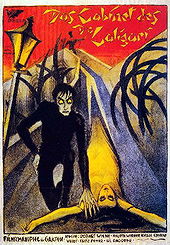Prior to F.W. Murau's Nosferatu there was Robert Weine's silent horror masterpiece Das Kabinett des Doktor Caligari (translated to the more common title; The Cabinet of Dr. Caligari). In the annals of the horror genre, these two instances of German Expressionistic cinema stand above all others as pivotal filmic creations. The Cabinet of Dr. Caligari is amid the few archetypal horror films accountable for influencing fundamental elements of horror. These aforementioned elements include: a mad scientist, a "monster" slave to its master (think Frankenstein...even though the novel was published a century beforehand), and the pangs of guilt triggered by beauty or kindness.
This is a strikingly different piece of cinematic history due to its sheer artistry and eerie atmosphere. Visually, the film is unmistakably Expressionistic: weird, contorted angles, dark shadows, as well as bizarre, surrealistic sets and just about anything else that could assault the normal perception. Cinematic Expressionism (often referred to as "Caligarism") fundamentally involves images speaking for themselves more than any text or speech. This film abides by said law. To design the stylised décor of the movie, director Weine hired Hermann Warm, Walter Rohrig and Walter Reimann. These men turned to the paintings of Edvard Munch and the Expressionist stage designs of revolutionary impresario Max Reinhardt to find inspiration for the cramped, crooked town of Holstenwall. It's a fairly dated film, but the sheer audacity of the film's physical and psychological conceit will haunt you forever.
The Cabinet of Dr. Caligari is a film that boasts numerous firsts - the first horror film, the first psychological thriller, and the first German Expressionist film. This is a true classic of international cinema, and one of the most avant-garde horror films of its generation. The horror may be superficially insipid and tame, and the acting is unsurprisingly relatively hammy, but the eerie and unsettling atmosphere in addition to the eccentric imagery generates a lingering feeling of haunting unease - and that's what horror films should do.
This chilling tale is of a fairground barker who misuses his hypnotic powers to compel a mournful cipher into doing his evil bidding. Beginning with a harmless day of fun, Francis and his good friend Alan (Von Twardowski) attend a fair that recently rolled into town. The fair's main attraction is the enigmatic Dr. Caligari (Krauss) who's exhibiting a Somnambulist named Cesare (Veidt). Cesare has been in an uninterrupted sleep for twenty-three years, and he knows the secrets of the past and the future. A curious Alan inquires when he will die...and Cesare reveals he'll be dead by dawn tomorrow. The small town is held under a grip of fear when the prediction proves true and Alan is murdered. However, this is not the first in recent days. Caligari and his Somnambulist soon become the prime suspects in a series of killings. Francis vows not to sleep until he catches the killer.
For a time during pre-production, Fritz Lang was originally assigned to direct. He claims he worked extensively on the screenplay, although this has never been proven. Given the brilliance of Lang's work (he went on to make masterpieces such as M and Metropolis) it would be fairly interesting to see what he'd have done with the film. If anything, the film could've used stronger direction. Robert Weine's direction is competent, but occasionally lacking solidity. Weine never made a masterpiece like this again, though he tried.
The final screenplay was written by Czech poet Hans Janowitz and Austrian artist Carl Mayer. A copy of the original shooting script disproves Janowitz's contention that the film's remarkable visual appearance had been devised by the writers. The design of Holstenwall was conceived by a separate creative team (whose names were mentioned before). On a more pragmatic level, an electricity shortage meant it was more efficient to paint in the lighting effects as opposed to using precious power. This subtle touch generates a heightened sense of menace.
Krauss and Veidt (who played Caligari and Cesare, respectively) were both Reinhardt alumni and were capable of fashioning their own grotesque make-up and exaggerated gestures.
German Expressionism can be perceived as inspiration for the depiction of supernatural images due to the techniques in relation to lights, shadows, out-of-focus images, and image juxtaposition. In spite of the surrealism depicted in Expressionistic movies, they always told a story related to common matters of human society. For example: the outsider (as shown in Murnau's Nosferatu) as well as prejudice and ignorance (Metropolis). The Cabinet of Dr. Caligari conveys a theme in relation to corruption that can easily affect humans, compelling them to act foolishly.
Robert Weine's The Cabinet of Dr. Caligari has always been considered a keystone of the horror genre. This is mainly a moody film, with its tone set by grotesque art direction. The deliberately ambiguous twist ending will come as a substantial jolt for a viewer. Rather than providing visceral shocks (ala Hostel, Saw, etc), Weine's masterwork plays games with the mind. It's interesting that while Germans created films with artistic merits, Americans were cranking out brilliant slapstick comedies (like the works of Charlie Chaplin) or morality tales. Thanks to the subversive nature of their films, the Germans ushered in a new era of filmmaking. Whether or not the film works depends entirely on your tolerance for silent cinema. If you have an interest in cinema in general, or if you're a horror fan keen to visit the roots of the genre, I recommend you check this one out. Robert Weine literally wrote the book of screen horror in 1920, and filmmakers have poured over it ever since.
8.2/10
 Login
Login